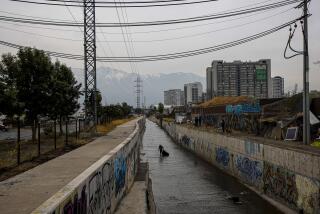Colombia housing market reflects region’s growth
- Share via
Reporting from Pereira, Colombia — The 50-year-old teacher is about to do something she’s never done, something remarkable in Colombia: Buy a home.
Inez Angel has her eye on a $35,000 split-level condo in the Villa Verde subdivision in the western Colombian city of Pereira. It is priced right, and the 15-year mortgage at a fixed 7% interest rate is affordable.
Just as important to her — and her country — is her confidence in Colombia’s future stability. Experts say homeownership can help a society lock in a sense of greater security.
A decade ago, Colombia was mired in conflict with leftist rebels. The few condos being built in Pereira were snatched up by narcos, who drove up prices, Angel said. Her homeowner friends were saddled with variable-rate mortgages that ballooned to 40% when the economy imploded.
“Things have quieted down and the credit you can get is very propitious,” said Angel, as she showed her sister Beatriz around the home. “I looked at all the factors and decided it was time.”
Many Colombians are arriving at the same conclusion. According to government figures, Colombian builders sold 152,000 new houses and condos last year, up 30% from 2009. Through July of this year, new unit sales nationwide were up 19% over the same seven months last year.
Even as homeowners continue to struggle in North America, ownership is growing rapidly in many parts of Latin America. Growth in home buying reflects the rising purchasing power of an expanding middle class, which, according to the World Bank, now forms 30% of the region’s population, up from 20% a decade ago. In Colombia, per-capita income has nearly doubled over the last five years.
The region’s commodities boom will push Latin America’s economies to grow at roughly triple the U.S. rate this year. The ripple effects of booming sales of copper, iron ore, coffee, oil and soybeans are lifting not just the housing market, but also auto sales, foreign travel and purchases of computers and other durable goods.
Pedro Gutierrez, a 30-year-old engineer in Chile, bought his first home this month, an apartment in the new Progesta development in a neighborhood of Santiago, the capital, where sales are expected to rise 15% this year.
“I’ve got the means now, my credit is good, and for payments that are more or less what I was paying out in rent, I can have an asset that’s all my own,” Gutierrez said.
Expanding homeownership is more than a reflection of a stronger economy, experts say. It can bring social stability and presage improved infrastructure and services in the surrounding areas. That’s because permanent residents have a greater stake and take more interest in their communities, said Sameh Wahba, an economist at the World Bank in Washington.
“People who acquire shelter are less vulnerable. Besides being an economic asset, shelter is a psychological one because buyers have tenure security,” Wahba said.
Eduardo Castro, a 32-year-old salesman for a multinational energy company, recently returned to Colombia after years of living abroad. His family is buying a high-rise unit partly because he is convinced prices will only go up.
“We got a loan easily because my wife and I both have stable jobs and prices here are not so bad compared with other countries,” Castro said.
Confidence in Colombia’s future is attracting other expatriates. In Pereira, as many as one-fifth of the 4,000 new housing units sold last year were bought by Colombians living abroad, or by foreigners married to Colombians.
“People from the U.S., Spain or the U.K. come here, like the climate, the lifestyle and the prices,” said Andres Uribe, sales manager at the Villa Verde subdivision, located in the northern sprawl of this city of 450,000.
In a telephone interview, World Bank economist Taimur Samad sees little chance of the kind of widespread crash experienced by the U.S. housing market in recent years, partly because of a huge pent-up demand that will tend to drive up prices.
Carlos Raul Yepes, president of Bancolombia, the country’s largest bank, said in a recent interview that to meet that demand, his institution’s mortgage loans could easily double over the next decade.
Carlos Huertas Campos, an economist with Colombia’s central bank, said mortgage lenders have learned from the country’s 1990s housing bubble and now generally are more conservative than their U.S. counterparts. They often demand down payments of 30%, making buyers less likely to speculate or walk away from their investments if times turn tough.
The World Bank’s chief economist for Latin America, Augusto de la Torre, said the risks in the housing market are more likely to result from insufficient supply, which can create bottlenecks and price bubbles. The region also suffers from shortages of experts such as brokers, appraisers and urban planners, he said.
“Demand will only rise in Latin America and so we have to fix the market so that supply is more robust,” De la Torre said.
Rapidly rising demand and stagnant supply have been blamed for a sales slowdown in Sao Paulo, Brazil, where prices have shot up by 50% or more in parts of the city. Poor mass transit makes commuting a nightmare there, thus adding to an exaggerated price premium for units in central areas.
A similar sales slowdown has been reported in Peru, but for different reasons. Industry consultant Gino Layseca said the government’s restrictions on credit to control inflation will cause a 30% decline in unit sales in the capital, Lima, this year.
The two urban markets may illustrate what the World Bank’s De la Torre describes as “structural speed limits to growth.”
“The difference between a BMW and another car is that you rev them up and the BMW doesn’t overheat. Latin America’s economy is far from being a BMW,” De la Torre said.
Kraul is a special correspondent. Special correspondents Jenny Carolina Gonzalez in Bogota, Colombia, Fabiola Gutierrez in Santiago, Chile, and Adriana Leon in Lima, Peru, contributed to this report.
More to Read
Sign up for Essential California
The most important California stories and recommendations in your inbox every morning.
You may occasionally receive promotional content from the Los Angeles Times.













